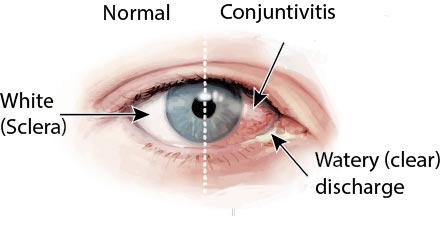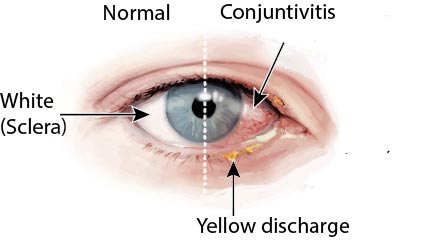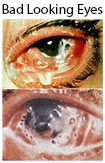Pink eye is usually caused by a mild inflammation of the white of the eyes and will go away on its own or with eye drops. But there are times when it can be more serious and cause vision loss so knowing the signs of a more serious infection is critical.
Pink Eye Causes
Pink eye is usually caused by a bacterial or viral infection of the conjunctiva, which serve as an outer protective layer that covers the white of the eye and the inside of the eyelids. There are some clues that can help you figure out which one you have like what your eye looks like and the time of year, as certain infections are more common in the winter or summer months.
Viral Pink Eye

Most pink eye is caused by the same virus that causes the common cold. It usually presents with a watery, clear discharge, itching and conjunctival injection or “pink eye” which is caused because infection of the conjunctiva causes blood vessels in the eye to dilate. Like the common cold, you can treat symptoms of the infection but you can’t kill the virus with medicine. Instead using a cold compress or lubricating eye drops can reduce uncomfortable symptoms that usually resolve on their own in one or two weeks. Infections with viral pink eye are common in the summertime and may be accompanied by common cold symptoms such as cough, sneezing or congestion. Viral conjunctivitis is very contagious so handwashing, use of hand sanitizers and use of disinfectant wipes to clean shared surfaces (keyboards, doorknobs) is important to prevent the spread of infection.
Bacterial Pink Eye

Bacterial pink eye is the second most common cause of conjunctivitis in adults and the most common cause of pink eye in children. It presents with itchy red eyes with a sticky green or yellowish discharge that is usually worse in the morning. The symptoms aren’t specific and more than 30% – 40% of individuals with bacterial pink eye may have no itching, only have a watery discharge or have no discharge at all. One telltale sign is waking up with your eyes glued shut from sticky discharge which is predictive of bacterial pink eye (Odds Ratio=15). It most common occurs from December through April and other contacts in your home or work with some of the other signs like a greenish discharge may also guide you to identify what type of pink eye you have. Unlike viral pink eye, treatment with topical antibiotics speeds up recovery of bacterial pink eye. Broad spectrum antibiotics (such as the fluoroquinolones gatifloxacin, moxifloxacin, ofloxacin, and ciprofloxacin) that are effective against a wide range of bacteria are recommended but research has not demonstrated that a particular set of eye drops (see table) work better than one another, so cost is a reasonable consideration when selecting an eye drop.
Allergic Pink Eye
Another common cause of pink eye is allergic conjunctivitis, usually occurring in spring and summertime to individuals allergic to dust, dander, pollen or other allergens. Allergies typically will repeatedly occur so a history of similar symptoms taking place around the same time of the year in prior years is a clue that pink eye may be caused by an allergy. Over-the-counter anti-histamines work well for allergic pink eye but can cause drowsiness. Several prescription eye drops like olopatadine (Pataday) work well to reduce the itching and clear discharge present in allergic pink eye.
Antibacterial Drops
Bacitracin (Ak-Tracin, Bacticin)
Chloramphenicol (AK-Chlor, Chloroptic,
Chloromycetin)
Ciprofloxacin (Ciloxan)
Gatifloxacin (Zymar)
Gentamicin (Gentak, Gentasol)
Levofloxacin (Quixin)
Moxifloxacin (Vigamox)
Neomycin (Neosporin)
Ofloxacin (Ocuflox)
Polymyxin B and trimethoprim (Polytrim)
Sulfacetamide (Cetamide, Ocusulf-10, Sodium
Sulamyd, Sulf-10)
Tobramycin (AK-Tob, Tobrex)
Bacteria Causing Pink Eye
Neonates
Chlamydia trachomatis
Staphylococcus aureus
Haemophilus influenzae
Streptococcus pneumoniae
Children
H influenzae
S pneumoniae
S aureus
Adults
S aureus
Coagulase-negative Staphylococcus organisms
H influenzae
S pneumoniae
Warning Signs
Pink eye can also be caused by a more serious infection or underlying cause but generally come with a warning sign such as eye pain, headache, constant blurred vision (that isn’t caused by discharge transiently obscuring your sight) or really bad looking yellowish or greenish discharge. Other warning signs include a history of other eye diseases or prior herpes infection of the eye, history of sexually transmitted infections (STI) or an active STI (eg gonorrhea, chlamydia) or if the infection took place following a hospital stay. Eye pain, constant blurred vision or really bad looking discharge are usually present in more serious cases. Eye pain may also present as photophobia, or light-sensitivity, which is a feeling of discomfort or pain in the eye after exposure to light. This is present if shining a light in your eye (eg penlight) or looking directly at a light bulb hurts. Sometimes people with light sensitivity prefer to stay in a dark room. Generally, more serious forms of pink eye require different types of treatment, so seeing an eye doctor is important. For example, an eye infected with chlamydia requires treatment with topical and oral or IV antibiotics.
Contact Lens Infection

Contact lenses can also complicate eye infections because they are often associated with infections of other parts of the eye and they can reintroduce infection back into the eye. Stop wearing contact lenses if you have conjunctivitis. Discard any disposable lenses. Replace contact lens holders and check with manufacture guidelines about how to clean a non-disposable contact lens before reintroducing it to an eye when the infection improves.
Other Pink Eye Causes
Acute glaucoma
Allergic conjunctivitis
Anterior uveitis
Blepharitis
Chemical conjunctivitis
Dry eye
Episcleritis
Foreign body
Infectious conjunctivitis
Keratitis
Scleritis
Subconjunctival hemorrhage
Warning Signs
Pain
Eye pain
Headache
Light Sensitivity
Blurred vision
Constant
S pneumoniae
S aureus
Infection
Prior herpes eye infection
STI (gonnorhea, chlamydia)
Hospital Acquired Eye Infection
What to do if you have an eye infection:
1) Determine if its bacterial, viral, or allergic
2) If its bacterial or you have a warning sign then see a doctor or an ophthalmologist
3) If you are unsure, see a doctor
4) Eye drops such as artificial tears or a cold compress may help relieve symptoms
5) Wash your hands frequently, especially after touching your eyes.
How long should it take to get better?
Without treatment simple cases of conjunctivitis get better within 2 weeks. If you are treated with topical antibiotics, your eye should start improving within 2 days. If eye symptoms don’t start to improve within 2 days after starting topical antibiotics or persist longer than 2 weeks, see a doctor.
The Short Summary
Most pink eye is caused by a virus in adults and bacteria in children. Pink eye in the winter months accompanied by mild yellowish sticky discharge favors a bacterial infection that should be treated by a topical antibiotic. Pink eye in the summer months presenting with a watery discharge in a person who doesn’t have allergies is probably viral. Artificial tears and cool compresses can help relieve symptoms of pink eye, which should usually clear itself within 2 weeks. If pink eye causes pain, blurred vision, looks really bad or lasts for longer than 2 weeks, see a doctor as it could be a sign of a more serious underlying condition.
[avatar user=”medwis5″ size=”145″ align=”left” /]Dr. Michael Morgenstern is a double board certified neurologist. He is also a health educator and publishes vital health information videos on DRMTV. He treats patients with medical marijuana at Morgenstern Medical at locations in Manhattan, Queens and Long Island. He is also the founder of the NY Medical Marijuana Association and can be reached at [email protected].
